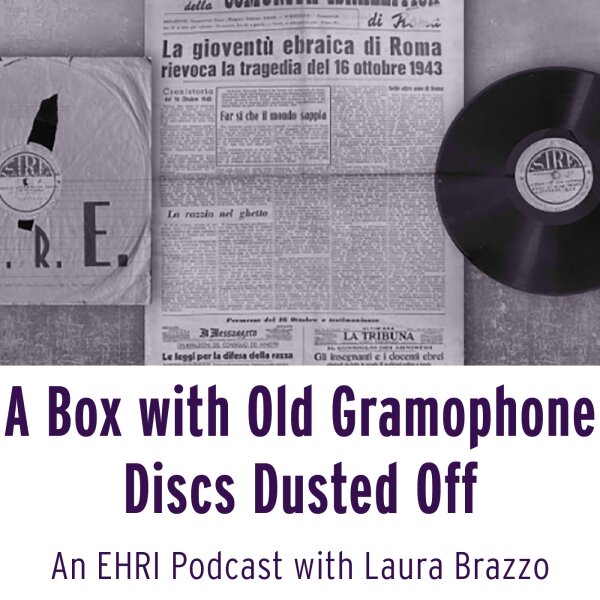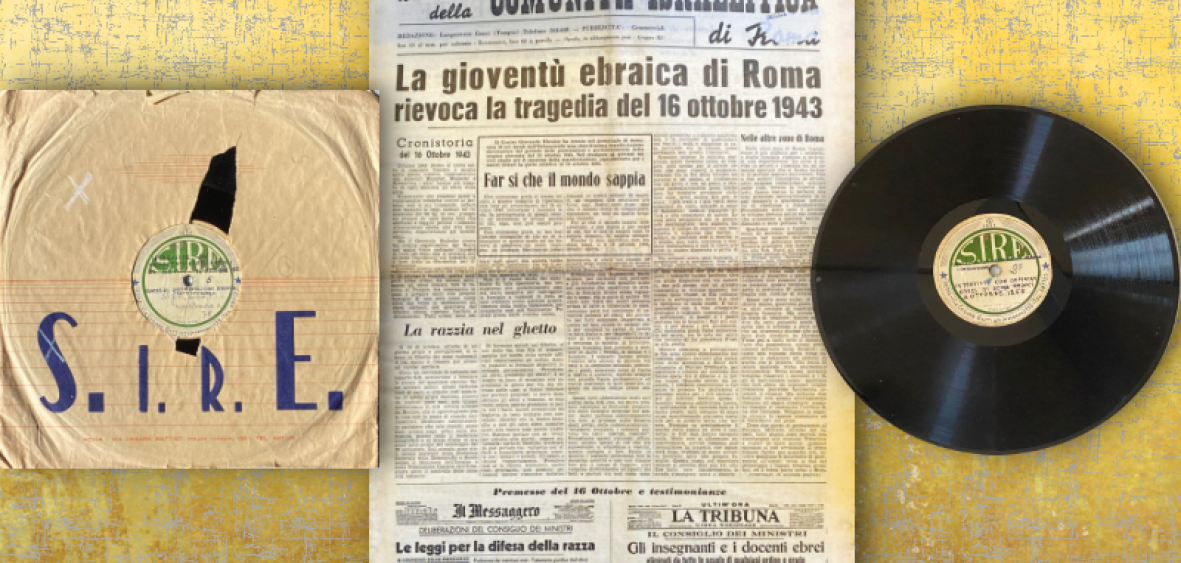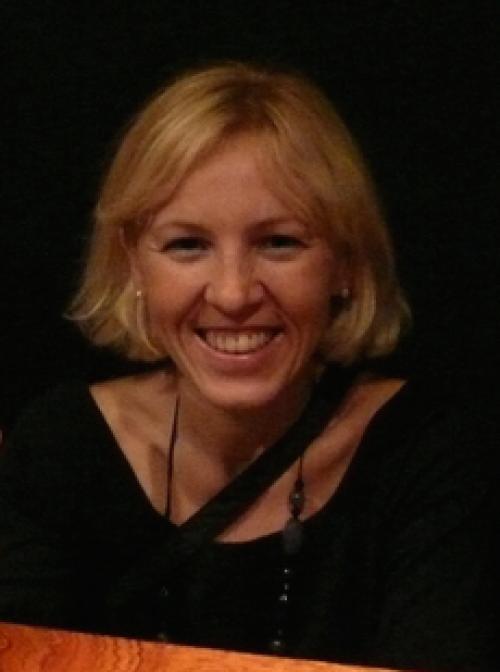
Release date: 8 December 2022 | More about the Podcast Series For the Living and the Dead. Traces of the Holocaust
In this EHRI Podcast episode, we will talk about the unique discovery of 33 vinyl discs, a hidden treasure in the archive of the Jewish Contemporary Documentation Center, CDEC, in Milan. The discs contain recordings of interviews given in 1955 by six of the sixteen survivors of the rounding up of the Jews of Rome on 16 October 1943, the infamous “Black Saturday”. One of the testimonies is by Cesare and Lello Di Segni, father and son, who gave account of how they survived the Holocaust.
These very early testimonies of the Holocaust were found by accident by Laura Brazzo, head of the Archive and Digital Library of the CDEC Foundation.
Featured guest: Laura Brazzo, Head of the Archive and Digital Library, CDEC Foundation, Milan, Italy.
Podcast host is Katharina Freise.
Laura will tell the story of Cesare and Lello Di Segni and how she rediscovered their voices on the lost records. Listen to the episode here or in your preferred podcast app (Buzzsprout, Spotify, Apple Podcasts, Google Podcasts):
Cesare: Io pensavo che ci avrebbero portati nel campi di lavoro per farci lavorare e che poi ci si riuniva la sera con la famiglia, non pensavamo mai che ci avessero portato via e che ci avessero distaccato dalla moglie e 4 figli, senza più vederli, senza salutarsi, senza dirci addio, un bacio ai bambini, nulla. Siamo rimasti proprio così, e da quel giorno lì non ho saputo più nulla.
Cesare: I thought they were going to take us to the labor camp to work and then we would get together in the evening with the family, we never thought that they would take us away and detach us from my wife and four children, without seeing them again, without saying goodbye, without a kiss to the children, nothing. We left them just like that, and from that day onwards, we never heard anything again.
From an interview with Cesare Di Segni, CDEC Foundation, 1955.

Cesare en Lello Di Segni, father and son, were two of the only sixteen survivors of the raid on the Ghetto of Rome on 16 October 1943. In 1955, unnamed interviewers from the CDEC asked them, and several other survivors, about their experiences. Only ten years after the war, these are very early testimonies and both interviewers as well as the survivors speak differently about what happened to them during the Holocaust (a term not yet in use in 1955) then in testimonies of later date.
Cesare Di Segni lived in the Jewish ghetto of Rome with his wife and four children, when Nazi Germany occupied Rome two days after the Italian surrender on 8 September 1943. He was a peddler and his oldest son, Lello, helped to provide for the family, after he was no longer allowed to go to school - one of the many anti-Jewish measures taken under Mussolini. On the morning of 16 October 1943, the family was unexpectedly rounded up, together with all the other Jews still in the ghetto. They had no idea what to expect when they were deported by train to Auschwitz two days later. There, Cesare and his son Lello, then 16, were selected for forced labour. The rest of the family, Cesare’s wife and three children were taken away. They were immediately killed in the gas chamber.
Also Cesare and Lello were separated. Cesare had to work near Auschwitz and further east in the coalmines. Lello was sent to the Warsaw Ghetto to clear rubble and then to Dachau. Both managed to survive and were liberated, Cesare by the Russians, Lello by the Americans. They made their ways back to Italy, where an empty house awaited. After some time, they were reunited.
“Black Saturday”
Shortly after the Italian surrender to the Allied Forces on 8 September 1943, Nazi-Germany occupied Rome. Approximately 8,000 Italian Jews had lived in the city, but many of those had moved south after the Allied landing, hoping to find safety from Nazi persecution.
Initially, it was hoped that action against the Jews of Rome would be avoided because of a condemnation from the pope, which however never materialised. On 26 September, Herbert Kappler, commander of the SS and the Gestapo in Rome, announced to the Jewish community in the city that unless they handed over fifty kilograms of gold, 200 Jewish family heads would be deported. The community delivered this sum with the assistance of the non-Jewish citizens of Rome. This left the Jewish community with the impression that they might be safe.
On the morning of 16 October 1943, 365 German security and police forces sealed off the Ghetto, which held a large part of the Jewish community at the time, turning it into a virtual prison.
In the following raid, 1,259 people were detained: 363 men, 689 women, and 207 children. Some non-Jewish prisoners were released while 1,023 Jews were taken to the Collegio militare in the Palazzo Salviati in Trastevere. Two days later, at least 1,035 prisoners were loaded onto trains at Tiburtina station and deported to Auschwitz. Only fifteen men and one woman survived.
Italy in the Second World War
The Kingdom of Italy, which had become a totalitarian state under Mussolini, entered the war alongside Germany on 10 June 1940. Its assault on Greece in October 1940 and the military struggles in the Balkans and in North Africa triggered German interventions. In turn, Italy joined Germany’s invasion of the Soviet Union in 1941. On 10 July 1943 the Allies, who had already occupied the Italian colonies in Africa landed in Sicily. Two weeks later, Mussolini was toppled by the king and arrested. In early September, the new Italian leadership signed a separate peace agreement with the Allies, who were in the process of invading southern Italy. This caused Germany to step in and occupy the remaining parts of Italy the Allies had not yet conquered. While the king and his government fled south, Mussolini was freed from prison by SS paratroopers and was allowed to set up the Italian Social Republic in Salò, northern Italy. The war front advanced very slowly: Rome was liberated in June 1944, Milan and the North in April 1945, when German forces withdrew from Italy altogether.
In 1938, the Italian Jewish community, one of the oldest and most integrated in Europe, numbered about 47,000 people. Mussolini’s party, the Partito Nazionale Fascista did not include anti-Judaism in its Statute until 1938, when harsh anti-Jewish legislation based on biological racism resembling the German Nuremberg Laws was implemented. Many adults were coerced into forced labour and foreign Jews saw almost all their residence permits cancelled. Still, between 1938 and 1943 there was no systematic state violence against Jews and they were not deported. When the Germans occupied Italy in 1943, the situation of the Jews in the central and northern half part of Italy worsened drastically. Jews were arrested by both the German and Italian police and gathered in provincial camps; from there they were transferred to the national internment camp, first at Fossoli, then at Bolzano. Here, the German police organised their deportation. The vast majority of deportees was sent to Auschwitz. Over 300 Jews died in massacres in various places and of the approximately 7,500 deported Jews, a little over 800 survived. Some thousand Jews took part in the Resistance. The remaining 30,000 or more lived in hiding, were able to reach Switzerland or the already liberated South. Overall, about 7,000 Jews from Italy perished during the Holocaust.
Laura Brazzo
 After receiving her degree in Contemporary History at the Università Statale of Milan and her PhD in Political Science, Laura Brazzo became involved in the activities of the Chair of Contemporary History at the Università Statale and with the Commission of History of International Relations.
After receiving her degree in Contemporary History at the Università Statale of Milan and her PhD in Political Science, Laura Brazzo became involved in the activities of the Chair of Contemporary History at the Università Statale and with the Commission of History of International Relations.
After ten years, she switched to archival work and received a Master’s Degree in Records Management, Document Flows and Electronic Records at the Università Cattolica del Sacro Cuore in Milan. Since 2005, she works at the Fondazione Centro di Documentazione Ebraica Contemporanea (CDEC). At CDEC, she became focused on topics related to the history of the Holocaust in Italy , which is the main area of research of the CDEC Foundation.
She is very interested in digital history. Since 2012, she has been in charge of the CDEC Historical Archive and since 2015 also of the Digital Library. She is one of the founders of the magazine Quest. Issues in Contemporary Jewish History.
Learn More
- Six Interviews from 1955 with the Survivors of October 16 1943, Found by the CDEC, in: Shalom. Comunità Ebraica di Roma.
- Laura Brazzo
- Fondazione Centro di Documentazione Ebraica Contemporanea (CDEC), Milan, Italy
- Italy in the EHRI Portal
- Raid of the Ghetto of Rome on Wikipedia
Credits
Our thanks go to:
- Cesare and Lello Di Segni
- Laura Brazzo and the Fondazione Centro di Documentazione Ebraica Contemporanea
- Music accreditation: Blue Dot Sessions. Tracks - Opening and closing: Stillness. Incidental, Gathering Stasis, Pencil Marks, Uncertain Ground, Marble Transit and Snowmelt. License Creative Commons Atttribution-NonCommercial 4.0 International (BB BY-NC 4.0).
- Andy Clark, Podcastmaker, Studio Lijn 14
